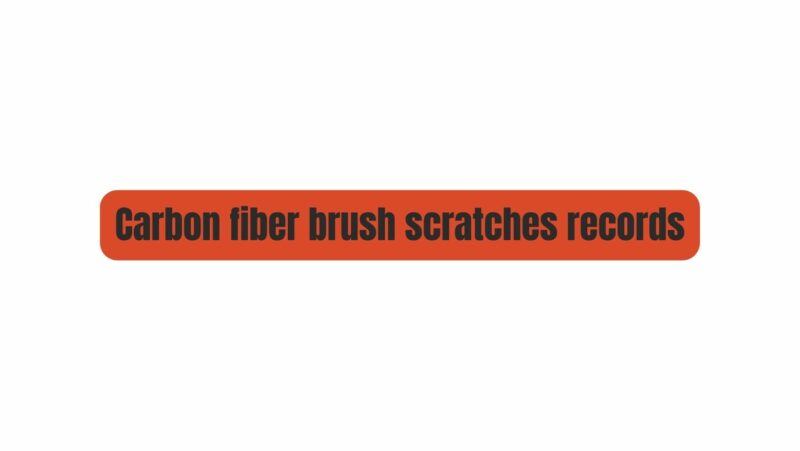Vinyl records, cherished for their warm analog sound and tactile appeal, have experienced a resurgence in popularity in recent years. As more people delve into the world of vinyl, questions about proper record care and maintenance have become increasingly common. One topic that often surfaces is the use of carbon fiber brushes and the concern that they may inadvertently scratch vinyl records. In this comprehensive article, we will delve into the science behind vinyl record care, examine the role of carbon fiber brushes, and determine whether they pose a genuine risk to your precious vinyl collection.
Understanding Vinyl Record Composition
Before we explore the potential impact of carbon fiber brushes on vinyl records, it’s essential to understand the composition of these beloved analog artifacts.
Vinyl records consist of multiple layers:
- Groove Layer: The top layer of a vinyl record contains the grooves, which are cut with great precision to store the audio information in the form of tiny variations in depth and width.
- Core Layer: Below the groove layer is the core, which provides structural support to the record. The core is typically made from a sturdier material than the groove layer to prevent warping.
- Label Layer: The bottom layer of the record features the label, which displays information about the artist, album, and track listings. It serves as a protective covering for the core layer.
Vinyl records are susceptible to various forms of damage, including scratches, warping, and surface debris. Proper care and maintenance are essential to preserve the audio quality and lifespan of vinyl records.
The Role of Carbon Fiber Brushes
Carbon fiber brushes are a common tool in the vinyl enthusiast’s arsenal. They are designed to help maintain records by removing surface dust and debris that can accumulate during playback. Here’s how carbon fiber brushes work:
- Anti-Static Properties: Carbon fiber brushes are known for their anti-static properties. Static electricity can attract dust and other particles to the vinyl’s surface, leading to pops and crackles during playback. Carbon fiber, being a conductor, helps dissipate static charges, reducing the attraction of dust.
- Gentle Cleaning: Carbon fiber brushes feature tiny bristles that are delicate and designed not to scratch or damage the surface of the record. When used correctly, they can effectively remove loose particles without harming the grooves or the vinyl itself.
- Maintenance Tool: Carbon fiber brushes are primarily used as a maintenance tool between plays. They are not meant to replace more thorough cleaning methods, such as using a record cleaning machine or a wet cleaning solution.
The Myth of Carbon Fiber Brushes Scratching Records
The idea that carbon fiber brushes scratch records is a persistent myth in the vinyl community. This misconception likely stems from a misunderstanding of how carbon fiber brushes work and how they should be used. Let’s address some common concerns and misconceptions:
- Carbon Fiber Bristles are Abrasive: It’s important to note that the carbon fiber bristles on these brushes are incredibly fine and soft. They are not abrasive like, say, a wire brush or sandpaper. When used correctly, they should not cause any damage to the record’s surface.
- Misuse and Mishandling: The most significant factor contributing to the myth of carbon fiber brushes scratching records is misuse. Some individuals may use excessive force when cleaning their records, thinking that pressing harder will result in a cleaner surface. This approach is not only unnecessary but can potentially cause damage.
- Dust Particles Can Be Abrasive: While the carbon fiber bristles themselves are not abrasive, dust particles trapped in the brush can become abrasive if not properly removed. Regularly cleaning and maintaining your carbon fiber brush is crucial to prevent this issue.
- Records Already Have Scratches: In some cases, records may already have fine scratches or imperfections. These imperfections can become more visible after using a carbon fiber brush, leading users to incorrectly attribute the damage to the brush itself.
Best Practices for Using Carbon Fiber Brushes
To ensure that your carbon fiber brush remains a helpful tool in your vinyl care routine and doesn’t contribute to any potential scratches, follow these best practices:
- Gentle Pressure: When using a carbon fiber brush, apply gentle and even pressure. Let the brush do the work—there’s no need to press hard.
- Brush Alignment: Always brush in the direction of the grooves, from the outside edge of the record toward the center. Avoid brushing in a circular motion.
- Clean the Brush: Periodically clean your carbon fiber brush to remove accumulated dust and debris. You can do this by tapping it against a clean surface or using a separate cleaning brush designed for this purpose.
- Storage: Store your carbon fiber brush in a clean, dust-free environment to prevent it from becoming contaminated.
Conclusion
Carbon fiber brushes are valuable tools for vinyl enthusiasts, helping to maintain the cleanliness of records and reduce the effects of static electricity. The myth that carbon fiber brushes scratch records can be dispelled by understanding their gentle and non-abrasive nature when used correctly. Scratches on records are more likely to result from mishandling, improper cleaning techniques, or pre-existing imperfections on the vinyl.
In summary, when used with care and in alignment with best practices, carbon fiber brushes can be an essential part of your vinyl record care routine, contributing to the longevity and audio quality of your beloved vinyl collection. As with any aspect of vinyl care, knowledge and proper technique are key to preserving the integrity of your records and enhancing your listening experience.


